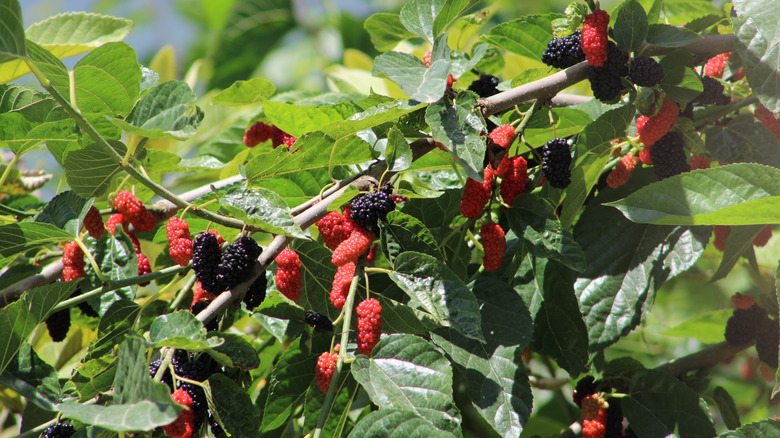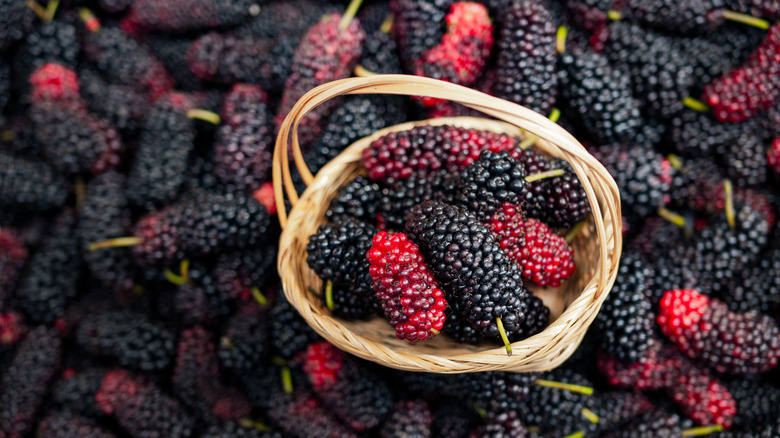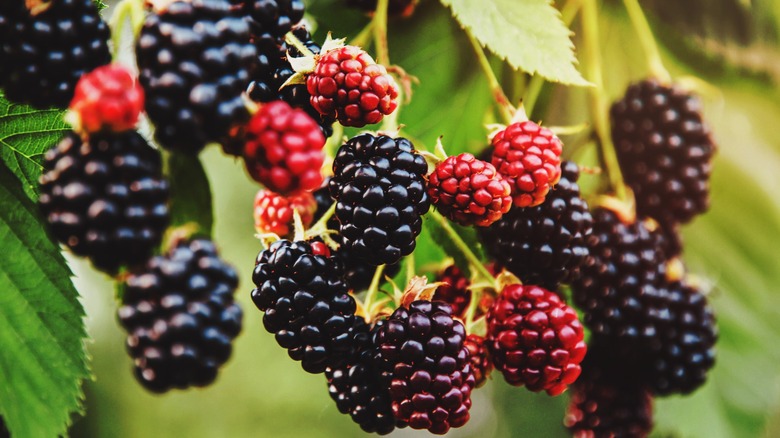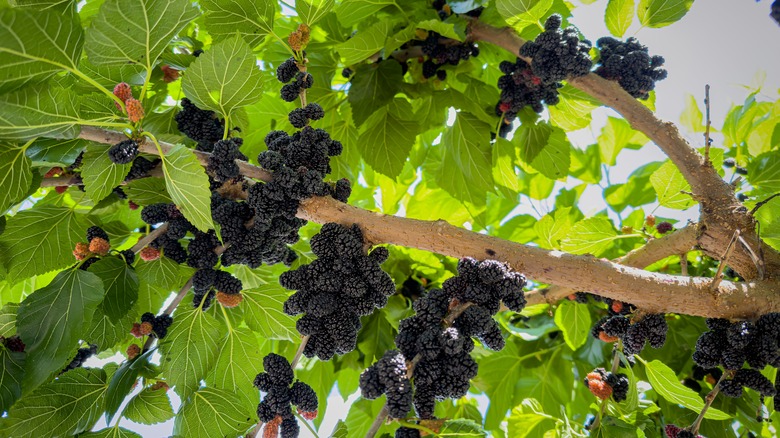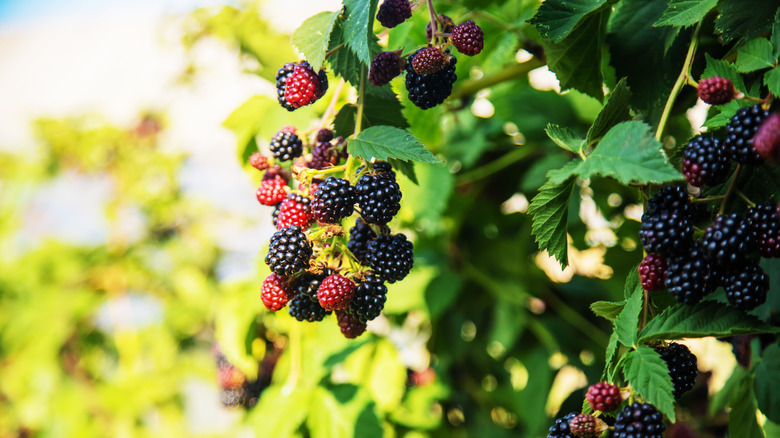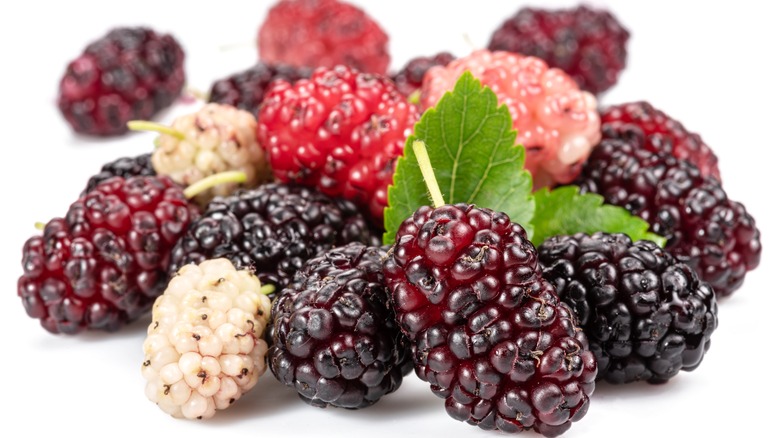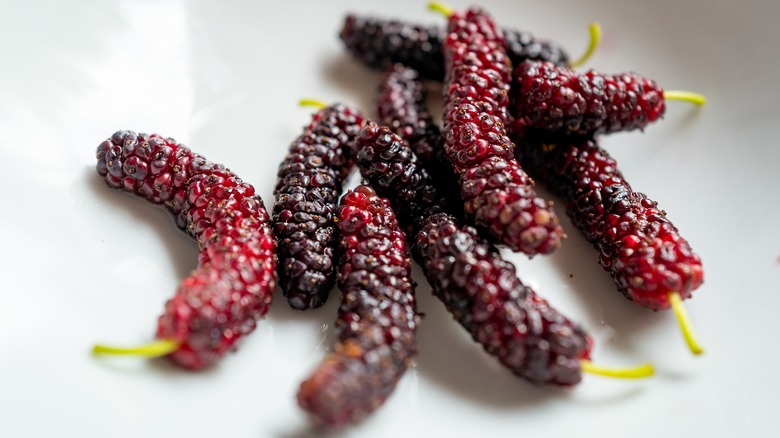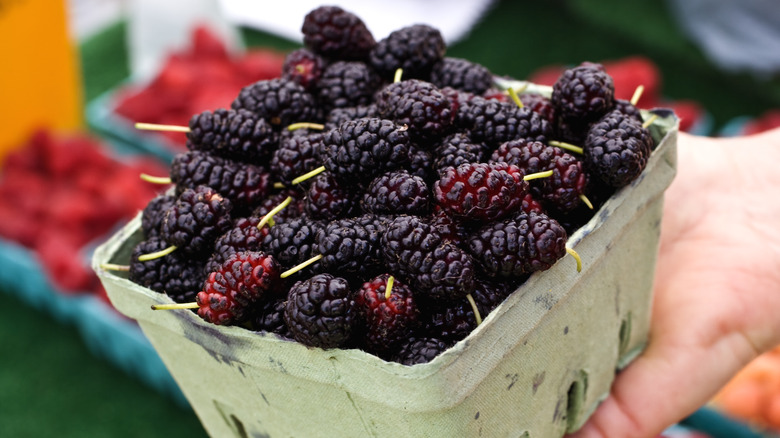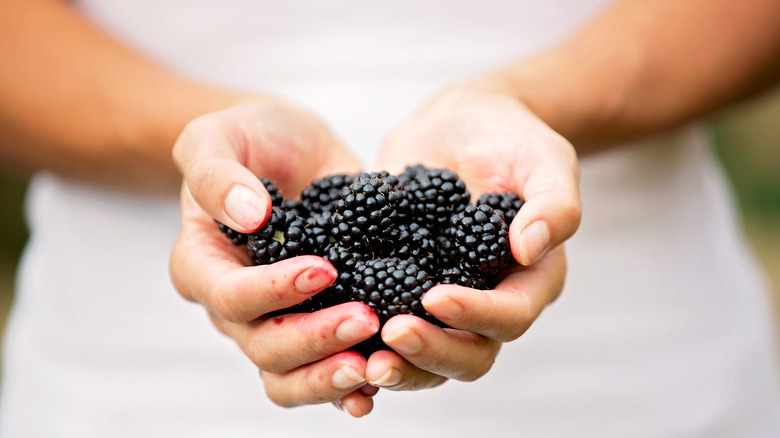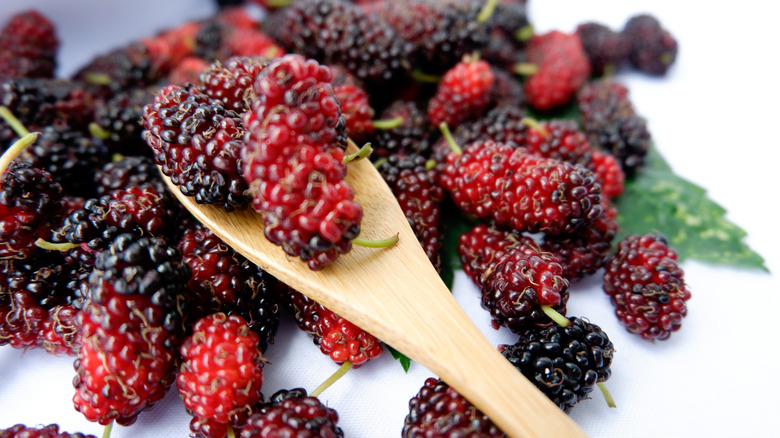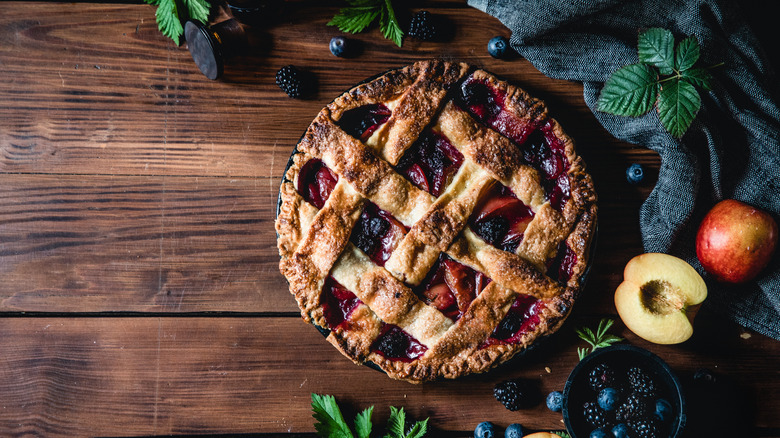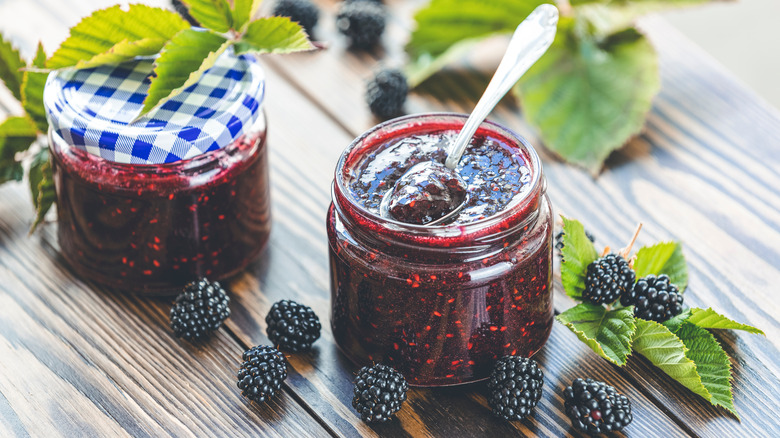Mulberries Vs Blackberries: What's The Difference?
They can look similar and they're both popular to forage, so we can understand the confusion that some people feel between mulberries and blackberries. While they might be alike in some ways, there are also plenty of differences between the two. If you're curious about these two tasty berries, now's your chance to learn what separates one from the other.
Mulberries and blackberries are two distinct species, so that's the obvious distinction, but what does this mean in real terms? You'll want to know how to tell the two apart just by looking at them, what they taste like compared to each other, and how they perform in cooking. You're about to become rich in berry knowledge and this is where your journey begins. Whether you want to forage for berries, cook with them, or you're just interested in the produce this world has to offer, we've got the information you need to tell the difference between blackberries and mulberries.
What are mulberries?
Mulberries are fruits that come from trees belonging to the Morus genus. These trees are versatile and adaptable, thriving in various climates, making mulberries a common sight in temperate regions worldwide. The mulberry fruits themselves can be classified into different colors — red, white, and black — depending on the specific variety of the Morus tree. Each variety has its unique flavor profile, contributing to the diversity of culinary applications for mulberries.
One of the fascinating aspects of mulberries is their historical significance. They have been cultivated for centuries, with evidence suggesting their consumption as early as ancient times in regions like China. Over the years, the popularity of mulberries has spread, and today, they are enjoyed in various cultures globally. Mulberries are versatile in the kitchen and can be consumed in various forms. Fresh mulberries are delicious, with their sweet and sometimes tart flavor. They can be eaten on their own, added to fruit salads, or used as a topping for desserts. Dried mulberries are another popular option, resembling raisins but with a unique taste. Mulberries can also be transformed into jams, jellies, and preserves, allowing their sweet essence to be preserved and enjoyed throughout the year.
Cultivating mulberry trees has become a pastime for many gardening enthusiasts, not only for the delectable fruits but also for the ornamental value they bring to landscapes. Mulberry trees are known for their relatively fast growth, providing shade, and adding a touch of natural beauty to gardens.
What are blackberries?
Blackberries are succulent and flavorful berries that belong to the Rubus genus of the Rosaceae family. These berries are native to various regions, including Europe, North America, and Asia, and are known for their rich taste, deep color, and numerous health benefits. Blackberries are composed of small drupelets, each containing a seed, and they are usually dark purple to black when fully ripe. Blackberries are not only enjoyed for their sweet, slightly tart taste but also appreciated for their versatility in cooking.
In terms of flavor, blackberries are prized for their juiciness and the perfect balance between sweetness and tartness. Their taste can vary slightly depending on the specific variety and ripeness. Blackberries can be consumed fresh, making them a delightful snack on their own or a tasty addition to fruit salads. They are also commonly used in desserts such as pies, cobblers, and tarts, as well as in jams, jellies, and sauces.
Blackberry picking, a popular summer activity in many regions, allows people to enjoy the experience of harvesting these delicious berries directly from the wild or cultivated bushes. Whether enjoyed fresh or incorporated into recipes, blackberries continue to be a beloved fruit that appeals to a wide range of tastes and preferences. Their vibrant flavor and versatility make them a great addition to the world of berries and a favorite in the realm of both sweet and savory dishes.
Mulberries grow on trees, blackberries grow on bushes
Mulberries and blackberries have distinct growth patterns, but some similarities. The main difference to note is that mulberries grow on trees, while blackberries grow on canes that form a bush or shrub. This is a simplification, however, so let's look more closely.
Mulberries grow on deciduous trees belonging to the Morus genus. The trees are typically medium-sized and can reach heights of 30 feet or more. Mulberry trees are known for their wide, spreading branches and heart-shaped leaves. There are different species of mulberry trees, which mainly fall into red, white, and black varieties. Mulberry trees produce small, inconspicuous flowers in spring. These flowers are often wind-pollinated. After successful pollination, the flowers develop into small, green berries. As the berries mature, they change color. The berries are usually ready for harvest in late spring to early summer, depending on the local climate. The fruits are plucked directly from the tree.
Blackberries grow on perennial shrubs belonging to the Rubus genus. They have thorny canes that arch and spread. Blackberry plants have two types of canes: primocanes and floricanes. Primocanes are the first-year growth and emerge from the crown of the plant. In the second year, the primocanes become floricanes. Floricanes produce lateral branches with clusters of small flowers. The flowers develop into green berries, which gradually turn red and then black as they ripen. Usually, they're ready for harvest in spring to late summer, depending on the variety and local climate.
Blackberry plants produce fruit sooner
The time it takes for blackberry plants and mulberry trees to produce fruit can vary depending on several factors, including the specific variety, growing conditions, and the age of the plant. However, you can count on blackberry plants to produce fruit sooner than mulberry trees.
Blackberry plants typically go through a two-year cycle. In the first year, the new shoots, called primocanes, grow vegetatively, establishing the plant's root system and structure. During this year, the plant does not produce fruit. In the second year, the primocanes from the previous year become floricanes. These floricanes produce extra branches with flowers that develop into fruit. Therefore, blackberry plants generally start producing fruit in the second growing season.
If you start mulberry trees from seeds, it takes around eight years for the tree to mature and produce fruit. That said, some smaller varieties of mulberry trees can take as little as four years before they fruit. Mulberry trees that are propagated through grafting or cloning from mature trees can start producing fruit much earlier, typically within two to four years, depending on the specific variety and growing conditions. So, blackberry bushes produce fruit significantly sooner than mulberry trees, especially those grown from seed. It's essential to be patient with both blackberry plants and mulberry trees, as the reward of fresh, homegrown fruit is well worth the wait.
Mulberries come in black, red, and white varieties
There are many varieties of mulberry trees, but they generally produce fruits that fall into one of three categories: black, white, and red. That said, it's important to note that the distinctions between black, white, and red mulberries can sometimes blur, especially when considering the various cultivars and hybrids that exist.
Black mulberries are named for their dark purple to almost black color when fully ripe. They're known for their rich flavor, often described as a blend of tartness and sweetness. Black mulberries are native to western Asia and have been cultivated in various regions worldwide. White mulberries can range from white to pink to lavender when ripe. They're generally sweeter and milder in flavor compared to black mulberries. The taste can vary among different cultivars. White mulberries are native to Asia and have been cultivated for thousands of years. Red mulberries range from red to dark purple when ripe. They have a sweet and tart flavor, somewhat intermediate between black and white mulberries. Red mulberries are native to North America, particularly the eastern and central regions. They are well adapted to a variety of habitats, including forests and riverbanks.
By contrast, although there are various cultivars of blackberry plants, they all produce deep purple to black fruits — hence the name blackberry. They look similar in color to black mulberries, which is where you might get confused.
Mulberries have an elongated fruit
Mulberries and blackberries have distinct shapes, so even though they're similar to look at, you can tell the difference by comparing the fruits. You know those tiny little ball-like pieces that make up a single blackberry or mulberry? Well, those are called drupelets. Mulberries are composed of multiple smaller drupelets clustered together on a central stem called a receptacle.
The overall shape of a mulberry cluster is typically lengthier and more elongated — appearing cylindrical or oblong. The individual drupelets are usually smaller and more tightly packed, creating a dense and structured appearance. The surface of each drupelet can be smooth or slightly textured, depending on the specific variety.
Blackberries are also composed of multiple drupelets, but they are arranged in a more rounded or globular cluster. The overall shape of a blackberry cluster is typically round, with the drupelets forming a spherical arrangement around a central core. The individual drupelets are larger and more distinct, with visible spaces or gaps between them. Blackberries often have a more irregular and "knobby" surface compared to the smoother appearance of mulberries.
So, mulberries tend to have a longer and more cylindrical shape with smaller, tightly packed drupelets, while blackberries have a rounder and more globular shape with larger, distinct drupelets. These differences in shape contribute to the visual distinctions between the two types of berries.
Blackberries are easier to buy
If you're looking for mulberries at your local grocery store — or even at a farmers' market — you're unlikely to have any luck. Blackberries, on the other hand, are widely available. You can even get them from Walmart. So, why the difference?
Well, the main one is likely to do with shelf-life. Blackberries generally have a good shelf life and can withstand transportation over longer distances, facilitating their distribution to various markets. Mulberries, being delicate and more perishable, may have a shorter shelf life and can be more challenging to transport without damage, impacting their availability in some areas. They generally only have a shelf-life of two to four days, once picked, making them impractical for most stores to carry.
However, it may also be an issue of supply and demand. Blackberries are commercially cultivated on a larger scale in many parts of the world due to their popularity and high demand. The commercial cultivation of blackberries often results in a more consistent and widespread supply. Mulberries aren't as popular, nor as widely grown commercially. The demand for mulberries is lower compared to blackberries, influencing their availability in stores.
While you may occasionally be able to buy mulberries in season directly from the grower, you shouldn't count on it. Learning the location of mulberry trees on public land in your area and knowing when to forage for them is your best bet for getting hold of mulberries.
Mulberries are generally sweeter than blackberries
Mulberries and blackberries have distinct flavors with subtle differences that contribute to their unique taste profiles. It's hard to describe the flavors of a fruit — to get a true idea, you'll need to taste both of them yourself — but, on the whole, mulberries are sweeter than blackberries.
The sweet taste of mulberries can vary depending on the specific variety, with some mulberries leaning more towards a honey-like sweetness and others being more balanced with a subtle tartness. However, the tartness is especially prominent when they are not fully ripe. Blackberries are still sweet, but this is almost always accompanied by a healthy dose of tartness. The balance between sweetness and tartness can vary among different blackberry varieties. But, overall, they're notably more tart than mulberries.
So, mulberries are known for their sweet, mild flavor with occasional tart notes, while blackberries have a richer and bolder taste with a pronounced tartness. Preferences for one over the other often come down to personal taste, as some individuals may favor the gentler sweetness of mulberries, while others enjoy the robust flavor of blackberries. We're casting no judgment here over which is better or worse — it's all about what you like more.
Blackberries have a more robust texture
One notable distinction between blackberries and mulberries lies in their texture. Blackberries often have a firmer and more robust texture compared to mulberries. The individual drupelets that make up a blackberry are filled with small seeds, contributing to a slightly crunchy or grainy texture. The seeds in blackberries are typically more noticeable, providing a subtle crunch when bitten into. Some people enjoy this added texture, which can enhance the overall eating experience. Despite the presence of seeds, blackberries are also known for their juiciness.
Mulberries, on the other hand, generally have a softer and more delicate texture. The drupelets are smaller and more tightly packed, creating a smoother and less crunchy experience. While mulberries do contain seeds, they are smaller and less prominent than those in blackberries. The seeds in mulberries contribute less to the overall texture, and the emphasis is often on the berry's softness. Mulberries have a thin, tender skin, adding to the overall gentleness of their texture.
The preference for one texture over the other is subjective and varies among individuals, with some enjoying the added crunchiness of blackberries and others favoring the gentler texture of mulberries. Ripeness also plays a part in texture. For instance, blackberries can be quite firm, but they can also be squishy and soft when very ripe.
Blackberries hold their shape better when cooked
Blackberries are known for their ability to hold their shape well when cooked, making them a popular choice for various culinary applications. This characteristic is attributed to their unique composition and the structural integrity of their individual drupelets. Of course, they soften and release their juices somewhat when cooked, but they keep their shape better than mulberries.
Blackberries can be used in a variety of cooking methods, such as baking, simmering, or making preserves, without losing their form completely. Whether incorporated into pies, cobblers, jams, or sauces, blackberries add a visually appealing element to dishes due to their ability to hold their shape. The retention of shape in cooked blackberries enhances the overall aesthetic appeal of dishes. The berries maintain a recognizable form, adding both visual and textural interest to desserts and other culinary creations.
Mulberries are more delicate and can become softer and less distinct when cooked. The individual drupelets in mulberries are smaller and may not have the same cohesive structure as blackberries. So, while they're delicious when cooked, you should be prepared for a looser texture and no sign of their distinctive mulberry shape.
Blackberries are higher in pectin
Blackberries are higher in pectin compared to mulberries, and this pectin content contributes to the natural gelling ability of blackberries. Pectin is a soluble fiber found in the cell walls of fruits, particularly in the skins and cores. It has the unique property of forming a gel-like substance when combined with sugar and acid under the right conditions, which is essential for the setting or gelling of jams and jellies.
So, blackberries inherently contain a higher concentration of pectin than mulberries and this natural pectin provides the necessary gelling agent for jam, which means making blackberry jam or jelly is a breeze. When blackberries are heated with sugar and acid (usually from added lemon juice), the pectin molecules in the fruit break down and interact with the sugar and acid. This process thickens the mixture and forms a gel, giving the jam its characteristic texture.
Due to their higher pectin content, blackberries often require no additional pectin supplementation during the jam-making process. This is in contrast to mulberries, which have a lower natural pectin level, so additional pectin is needed for the jam to set properly.
